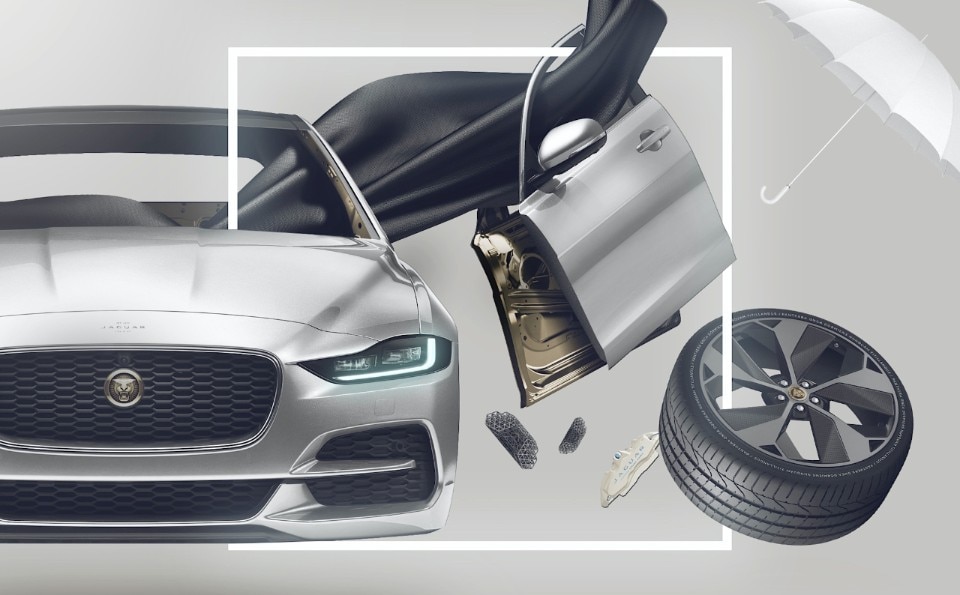The deconstructed silhouette of the new Jaguar Xe forms the heart of The Future Legacy, Jaguar’s installation exhibited in the cloister of Teatro Paolo Grassi during the Milan Design Week. It’s meant to be a voyage through heritage and innovation, and it was developed by Ian Callum, Jaguar Director of Design, with Andrea Rosati, the company’s Design Manager Advanced Colour and Materials. “We’re deconstructing it to demonstrate the combined beauty of engineering and art. We have a whole imagination of what we can do in the future with the materials of a luxury car, that is more sustainable and more interesting. Sustainability is really important and often people don’t consider that 95% of a car at the end of its life is recycled, and that’s a fact when you’re designing and engineering a car”.
What’s the relationship between Jaguar and design?
The design has always been fundamental for Jaguar. Has a long tradition of design and it’s important to show our observers, our customers that design still matters and still matters to us. It’s fundamental to exercise both the part of aesthetics and the part of engineering. Our design philosophy is to create something both exciting and beautiful and the part of beauty is still very important to Jaguar. That’s one of the reasons why we are coming to Milan. It’s the best thing that a product can do, to affect you emotionally.
There are lots of changes in the car industry. What are the values of Jaguar that remain?
Our design philosophy is to design something beautiful. If you look in the story of Jaguar you’ll see that every car is very different, but there’s something in common: elegance, a sense of beautiful line, understated perhaps, and those values will prevail regardless of any change. The change may come around in shapes, or space or dynamics, but it doesn’t change the value. If you take an I Pace and an XE, they’re totally different cars, with different profiles. Driving is not about speed, is about geometry, about how it feels.
If you look in the story of Jaguar you’ll see that every car is very different, but there’s something in common: elegance, a sense of beautiful line, understated perhaps, and those values will prevail regardless of any change.
What’s the main difference between designing an electric car instead of a petrol car.
The mechanical set of a traditional car has been developed now for one hundred years and it takes a specific amount of space in a very specific way. An electric motor is much smaller, so we have more freedom, there’s space available for other volumes, and you can create different profiles. Batteries take up space and these kind of cars have to be taller.
And what about sustainability?
Electric vehicles are far more energy efficient than internal combustion engine vehicles and generate zero tailpipe emissions. The batteries can be charged with renewable electricity – solar, wind or hydro for example. The battery can have a long and very productive second-life use until the end of useful their life, then they can be recycled.
Do you foresee a huge leap in cars’ evolution?
In terms of absolute design, cars won’t be so much different. I don’t think that cars will be so different in how we design them outside, but maybe it will change how we use them on the inside.
There have been lots of news about driverless cars, in the last few months
Yes, that is happening. We are not designing them but we’re investigating. There are 5 levels of autonomy. Level 1 is driver assistance, level 5 is full automation, and that will come and have an effect. If you make level 5 possible, then the temptation is to make the car a more sociable space, because nobody is driving. But one aspect to consider is that there’s a lot of pleasure in driving, especially sports cars, and so does it make sense a sports car that nobody drives?
Will Jaguar still produce “traditional” cars in 50 years, maybe for car lovers or collectors?
I think this is not a question which we can answer now. It depends on what people will want in 50 years from now. Young people that I know and are under 20 don’t even drive so much anymore. It’s not even clear if people will own things like they do now. But I think that people will still want something that belongs to them, even people who rent apartments don’t have to share them with 20 more persons.
I had the chance to drive Jaguar’s fully electric car, the I-Pace. The main issue was that you have to recharge it quite often. Are our cities ready for electric cars?
Something must change. I empathize with you. I had an I-Pace for six months and drove 10 thousand kilometres. - quite enjoyed it. I had chargers in every place, work chargers, home chargers. I think that the structure will dramatically change in the next few years, I think about London, but even Milan, that’s similar. Governments local and national must take care of this, they’ll have to somehow create the infrastructure.
- Installation:
- The Future Legacy
- Brand:
- Jaguar
- Venue:
- Piccolo Teatro Grassi
- Opening dates:
- 9th-14th April 2019



